 |
1991
The Year
The World Changed
xxxxxxxxxxxxxxxxxxxxxxxxxxxxxxxxxxxxxxxx |
|
|
At
pivotal moments throughout history, technological
innovation triggers massive social and cultural
transformation. Apparently unrelated
developments, which had been gradually unfolding
for years, suddenly converge to create changes
that are as disruptive as they are creative.
We are currently living in a moment of
extraordinary complexity when systems and
structures that have long organized life are
changing at an unprecedented rate. Such
rapid and pervasive change creates the need to
develop new ways of understanding the world and
interpreting our experience ~ Mark C. Taylor, "The
Moment of Complexity: Emerging Network Culture"
|
|
The year the
world changed was 1991.
1991 was the first year of the
Information Revolution - and the Administrative Coup d'etat on
America. There are several specific events
that kicked off the revolution and from today you can trace
back and see that the inexplicable and
un-American actions of this government can be traced back to that year.
|
-
Senator Al Gore ushers through the 1991 High
Performance Computing and Communications Act.
▪
Vision for a National
Information Infrastructure which Gore called the
"information superhighway". The
concept of the NII changed almost immediately to
the 'Global Information Infrastructure' (GII)
after passage of this legislation.
▪
Funding for the build
out of the communications lines (Internet) as we
know it today.
▪
Money for Research &
Development
▪
Open Use -
educational, public and commercial use
-
Tim
Berners-Lee, Cern Switzerland released - free for
use by all, the world wide web development and
navigation protocol: HyperText Markup Language
(HTML). It provided a simple way to format
documents and screens and it included navigation
capability through the use of embedded hyperlinks.
-
Corporate redesign of government administrative
functions and
infrastructure using high technology management
and control systems by people who never read the
U.S. Constitution. Deregulation of
corporations. Regulation and control of
people.
▪
Strategic Plan for the Intelligent Vehicle Highway System is
published concurrently with the passage of ISTEA
▪
Intermodal Surface
Transportation Efficiency Act of 1991 (ISTEA) - legislation to
enable building high tech
highways,
federalized major arterials and feeder routes to
transportation hubs, plans for empire include Mexico
and
Canada Pan-American Highway.
▪
Design for nationalized medical
records system is considered viable and work begins
▪
National Center for Education
and the Economy is working on a design for a 'National Human
Resource
Development System' - federal management of the labor
force. The system is described to Hillary Clinton in a
letter
in 1992.
▪
George H.W. Bush established the
New American Schools Development Corporation "to funnel
corporate
money
into innovative designs for 'New American Schools'"
Douglas D. Noble
-
End of the Cold
War
"The
creation of the Commonwealth of
Independent States on
December 21,
1991 signaled the dissolution of the
Soviet Union and, according to
leaders of Russia, its purpose was to
"allow a civilized divorce" between the
Soviet Republics. Since its
formation, the member-states of CIS have
signed a large number of documents
concerning integration and cooperation
on matters of economics, defense and
foreign policy.
From a
historical point of view, the CIS could
be viewed as a successor entity to the
Soviet Union, insofar as one of its
original intents was to provide a
framework for the disassembly of that
state. However, the CIS is emphatically
not a state unto itself, and is more
comparable to a loose
confederation more similar to the
European Community than to the
European Union that followed.
Although the CIS has few supranational
powers, it is more than a purely
symbolic organization, possessing
coordinating powers in the realm of
trade, finance, lawmaking, and security.
The most significant issue for the CIS
is the establishment of a full-fledged
free trade zone / economic union between
the member states, to have been launched
in 2005. It has also promoted
cooperation on democratisation and
cross-border crime prevention."
[Wikipedia]
- Nunn-Lugar Cooperative Threat Reduction Program
|
|
|
|
World Wide
Web

|
|
Fiber Optic
Cable

|
|
National Information Infrastructure

Donna Cox and Robert
Patterson, National Center for Supercomputing
Applications/University of Illinois
DOD Software and the NII
Nationalized
Medical Records (NII) |
|
Global
Information Infrastructure

Dynamic Connection History - International
Global
Information Infrastructure - Background
|
1990's Gold Rush
~ Gold fever is a
brain stem disease that prevents higher
order thinking. The symptoms are unbounded
greed and lust for wealth. It's
highly contagious and can be deadly. ~
In 2006, Robert Bradley, a
former speechwriter for Ken Lay (Enron), gave a
presentation to the Houston Forum on his analysis of the
reasons for the downfall of Enron. What Bradley was
describing without saying it was that
Gold Fever had struck Enron. It corrupted the
culture of the corporation leading to it's spectacular
downfall - bankruptcy, lost fortunes, lost and ruined lives.
Quotes
from Bradley’s presentation
-
Ken Lay had a business model. That model was
perpetual first mover advantage - a model of
revolutionary change or revolution always over
incremental improvement. It’s baseball season now
so the analogy would be to swing for the fences
and don’t use the strategy of the small ball: the
walk, the steal, the sacrifice, scoring runs that
way - go for the fences.
-
…the
guru of Ken Lay and Enron’s business model - Gary
Hamil. Hamil was a Drucker disciple who brought
the discontinuity revolution to new heights in his
book, “Competing for the Future and Leading the
Revolution”. …Don’t transform your organization.
Transform your industry. Don’t be a rule taker,
be a rule maker - no more, be a rule breaker. How
many of us at Enron remember all the
presentations: ‘rule taker, rule maker, rule
breaker. “We’re the rule breaker”. “We’re
revolutionaries”.
-
Speaking of revolutionaries, there is an Enron
mouse pad: “What are you going to do to change the
world today”. And there are interviews with Andy
Fastow during this period: “I’m a revolutionary”.
-
There was a conference in New York City by Gary
Hamil on revolution, “Revolt, Revolt” and Ken Lay
was scheduled to appear and this was less than a
month before Enron’s bankruptcy
-
Ken Lay’s business model put in practice is
something like this - there are great pools of
potential profits just awaiting entrepreneurial
discovery and action - opportunities that the
stodgy competition has not or cannot see. By
employing and empowering the best and brightest,
potential profits can be turned into actual
profits.
Enron wasn't the only company
that caught Techno-Gold Fever. Wall Street caught
Techno-Gold Fever as did the government, the main steam
media (CNBC, FNN), the military and defense contractors.
The opportunities for change that were made available by the
connectivity of the Internet set off a Gold Rush
unparalleled in history.
The problem was that the
Internet and PC-Network software industry were in their
infancy - not ready for prime time use. The only
people who really understood the dangers of connectivity to
worlds outside the organization were the IT professionals.
These IT professionals were neutralized by the 'Total
Quality Management' training. Experienced people were
labeled as "legacy" - meaning they didn't understand the new
technologies and new ways of thinking and designing systems.
This allowed the Techno-Youth with Techno-Lust guided by
Techno-Sharks with Techno-Gold Fever to be free to design whatever wanted -
"breaking all the rules" - which led to massive
corporate bankruptcies, thefts and losses that stagger the
imagination, chaos in organizations due to system defects
and security holes, unprecedented corruption
and ultimately to a coup d'etat on our government.
|
|
Clinton-Gore "Reinvent of Government"
"In 1993, with
Executive Order 12862, the
President called for a revolution in
government’s customer service to deliver services
equal to the best in business." September
11, 1993
|
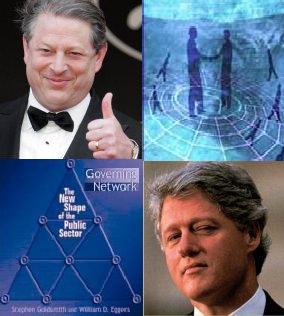
In 1993, President Clinton
asked me to figure out how to make government work better
and cost less. We called it reinventing government. The need
to reinvent was clear...Corporate America had reinvented
itself to compete and win. The same ideas and some new
wrinkles were starting to work at the state and local level.
But it was going to be incredibly difficult, the largest
turnaround ever, and management experts said it would
take at least eight years. [That's a joke most
people didn't get]
"Identify your customers and win them over"
New Federalism |
|
 |
Blair House Papers - Page 39:
Privatization initiatives are
underway at the Alaska Power Administration, the Interior
Department's Helium Field Operations (Amarillo), the Naval
Petroleum Reserve (Elk Hills), and the U.S. Enrichment
Corporation...
GSA will close nine data
centers, outsourcing all of its data center requirements to
the private sector. |
|

Gaebler - Powerpoint to Canadian Government
"We
Need a Government Revolution"
(Gaebler Slide 20) |
"Among intellectual currents,
managerial diagnoses and reforms have gained international
preeminence among the three models. Osborne and Gaebler
(1993) Reinventing Government is the touchstone of
most managerialists. It has been translated into dozens of
languages and sits on the book shelves of many reformers
around the world. It inspired the Gore program, and was
prominent in the Bresser Plan."
Footnote |
|
Reinvention
of Government
Means Unholy Alliances
1991 -
Strategic Highway
Network (STRAHNET) and STRAHNET Connectors, excerpt from
the
DOD STRAHNET Guide
"The Intermodal
Surface Transportation Efficiency Act of
1991 and the National Highway System
Designation Act of 1995 provided for
inclusion of STRAHNET and important
STRAHNET Connectors in the 160,955-mile
National Highway System (NHS). The
primary Connector routes for the
Priority 1 and 2 installations and ports
are included in the NHS. Federal
oversight will ensure optimum
maintenance levels for the NHS, thus
assuring that the roads can support an
emergency deployment. With DOD’s current
emphasis on continental US-based
military units, the NHS will play an
increasingly important role in new
deployment scenarios."
As the Department of
Defense (DOD) designated agent for
public highway matters, the Military
Surface Deployment and Distribution
Command Transportation Engineering
Agency (formerly Military Traffic
Management Command Transportation
Engineering Agency (MTMCTEA)) is the
proponent for STRAHNET and STRAHNET
Connectors. SDDCTEA identified STRAHNET
and the Connector routes in coordination
with the Federal Highway Administration
(FHWA), the State transportation
departments, the military Services and
installations, and the ports. Together,
STRAHNET and the Connectors define the
total minimum defense public highway
network needed to support a defense
emergency.
Strategic Highway
Network (STRAHNET) and STRAHNET Connectors
"The
Strategic Highway Network (STRAHNET) is
critical to the Department of Defense's
(DoD's) domestic operations. The
STRAHNET is a 62,791-mile system of
roads deemed necessary for emergency
mobilization and peacetime movement of
heavy armor, fuel, ammunition, repair
parts, food, and other commodities to
support U.S. military operations. Even
though DoD primarily deploys heavy
equipment by rail, highways play a
critical role.The Surface
Deployment and Distribution Command
Transportation Engineering Agency (SDDCTEA)
is the DoD designated agent for public
highway matters, including STRAHNET and
STRAHNET Connectors. The SDDCTEA
identified STRAHNET and the Connector
routes in coordination with the Federal
Highway Administration (FHWA), the State
transportation departments, the military
Services and installations, and the
ports. Together, STRAHNET and the
Connectors define the total minimum
defense public highway network needed to
support a defense emergency."
|
|
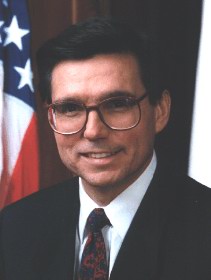
Dot Secretary
Federico Peña
Jan. 1993 - Feb. 1997
Pena -
Wiki Profile
Federico's
Folly (Denver Airport) By Michael Fumento, American
Spectator
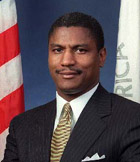
Federal Highway Administrator
Rodney E. Slater - Jan 1993 - Feb 1997
Dot Secretary Feb. 1997 - Jan. 2001
|
The National Highway
System
Backbone of our National19.1
"On December 9, 1993, at
Union Station in Washington, D.C., U.S. DOT Secretary
Federico Peña and FHWA Administrator Slater announced the
submission of the
National Highway System (NHS) plan to
Congress. Peña also outlined his principles and goals for a
National Transportation System (NTS)."
"Union Station serves as a
fitting backdrop for the unveiling of the National Highway
System," said Slater. "Just outside the station, Louisiana
Avenue is part of the National Highway System --
demonstrating how the National Highway System can provide
links among the many modes that make up our transportation
network. In fact, the National Highway System enhances the
other modes by linking them.
....
"A comprehensive National
Transportation System will help us meet the challenges of
the 21st century global economy by enhancing all our
different modes of transportation and their links --
increasing the efficiency and productivity of our nation,"
Peña said.
NTS will incorporate from all the modes the most significant
elements of the nation's transportation systems. Beginning
with NHS, NTS will include airports, ports, waterways, rail,
intercity bus lines, pipelines, and local transit systems
with regional and national impact. NTS will also include
systems moving both people and freight as well as facilities
owned by both private business and the public sector.
NHS is the core of the future NTS.
Slater explained NHS in
detail: "The first component of the proposed National
Highway System is the 45,000-mile interstate system, which
accounts for nearly 30 percent of the proposed system
mileage.
"The second component includes 21 congressionally designated
high-priority corridors as identified in the ISTEA. These
corridors total 4,500 miles. |
|
"The third component is the non-interstate portion of the
Strategic Highway Corridor Network (STRAHNET), identified by
the Department of Defense in cooperation with the Department
of Transportation. It totals about 15,700 miles. Based on
the most recent information, including plans for base
closures, these corridors and the interstate system have
been identified by the Department of Defense as the most
critical highway links in our transportation system. As we
found during Desert Storm, highway mobility is essential to
our national defense by giving us the ability to move troops
and equipment to airports, to ports, to rail lines, and to
other bases for rapid deployment.
"The fourth component is major Strategic Highway Corridor
Network connectors. They consist of 1,900 miles of roads
linking major military installations and other
defense-related facilities to the STRAHNET corridors.
"Collectively, these four components -- all specifically
required by ISTEA -- account for 67,500 miles or roughly 43
percent of the proposed system.
"The remainder of the proposed system -- totalling 91,000
miles -- is made up of other important arterial highways
that serve interstate and interregional travel and that
provide connections to major ports, airports, public
transportation facilities, and other intermodal facilities
...
"The National Highway
System will also strengthen our links with Canada and
Mexico, especially by providing some of the vitally needed
north-south connectors. Today, even before NAFTA (North
American Free Trade Agreement) goes into effect, trucks
carry about 80 percent of freight shipments between the
United States and Mexico and about 60 percent of freight
shipments between the United States and Canada. When NAFTA
removes trade barriers next year, as well as barriers to
international trucking operations, traffic on all modes
should increase significantly. The National Highway System
will serve this traffic efficiently by linking with the
Canadian and Mexican highway systems in a high-performance
network spanning most of North America. |
|

U.S. Secretary of Energy
Hazel O'Leary
Jan. 1993 - Dec. 1997 |
National Intelligent
Vehicle Highway System
Program Plan
Report to Congress
"America’s economic future
depends on the Nation’s capacity to invent and master new
technologies. It depends upon moving ideas to the
marketplace to spur growth, create new jobs, and strengthen
our industrial performance. Vice President Gore has
identified broad initiatives that together will restore
America’s technological leadership and reinvigorate our
economy. The Vice President’s technology initiative
emphasizes that investing in infrastructure means more than
building and repairing bridges, harbors, and highways. Today
the United States faces a new series of communications,
transportation, and environmental needs for the 21st
century."
|
|
"The Department of Transportation’s (DOT) Intelligent Vehicle
Highway Systems (IVHS)
program is a key component in this national technology
initiative. IVHS will harness
emerging communications. computer, and surveillance
technologies to address our most
challenging surface transportation problems. Early
indications are that IVHS applications can
improve traffic flow in congested urban corridors, provide
safer and more secure travel,
reduce the harmful environmental impacts of traffic
congestion, and help American travelers
and businesses achieve new levels of productivity.
....
Defense Technology Conversion
The United States is the world leader in many
technologies applicable to
IVHS, and numerous efforts are currently underway to assess
the feasibility
of converting existing aerospace and defense technologies to
IVHS. For
example, DOT and the Department of Energy (DOE) entered mto
a
Memorandum of Understanding on August 6, 1993, that will
promote the use
of the defense technology expertise of DOE’s national
laboratories in DOT’s
IVHS program.
Discussions have also taken place between DOT and various
elements of the
Department of Defense (DOD) and the Advanced Research
Projects Agency
(ARPA) to convert applicable defense technologies to IVHS.
Potentially
applicable technologies include: high-definition imaging and
displays, advanced sensors (e.g., infrared, microwave,
acoustic), radar/lidar
technologies, simulation modeling, telecommunications,
advanced software
(e.g., systems control, image processing, and data
infusion), artificial
intelligence technologtes, and vehicle robotics and location
systems.
The GPS system. with its network of satellites, IS
already a component of
many IVHS systems. DOT has been identified to work closely
with DOD to facilitate the proper implementation of GPS for
civilian use, and to ensure the
long-term availability of GPS as a U.S. national asset that
would be available
to civilian users worldwtde.
The defense industry already recognizes the potential of the
IVHS program,
and some 50 defense organizations are members of IVHS
AMERICA,
including ARPA, the U.S. Tank and Automotive Command (TACOM),
Martin
Marietta, and Hughes Aircraft, In addition, over 20 defense
community
contractors are participating in the AI-IS Precursor Systems
Analyses studies
and ten defense contractors are involved in the development
of the national
IVHS system architecture. Continued utilization of the
resources represented
by the defense and aerospace industry will be instrumental
in advancing the
national IVHS program and bringing IVHS systems to
deployment."
|
|
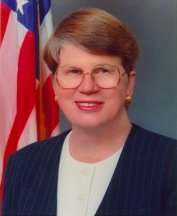
Janet Reno, Attorney General
March 1993 - January 2001
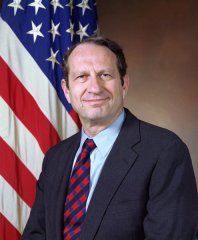
John Deutch, Deputy Secretary of
Defense
1994 - 1995
|
Partnership Between DOJ and DOD
1994 - NCJ 164268 - "Partnership" Between Law
Enforcement and the Military
"In 1994 the
U.S.
Department of Justice (DOJ) and the U.S.
Department of Defense (DOD) entered into a
cooperative agreement to develop technologies of
value to both. This agreement, codified in a
Memorandum of Understanding (MOU) and signed by
the Deputy Secretary of Defense and the Attorney
General, formalized and focused a longstanding ad
hoc relationship. To manage this technology
development program and to direct its day-to-day
activities, the MOU established a Joint Program
Steering Group (JPSG) that would represent both
departments and be staffed with members from
several agencies."
[MOU Source:
"The Development of 'Non-Lethal' Weapons During The 1990's"
footnote 26. Researcher Amanda Teegarden, OK-Safe]
Warrior Cops: The Omnious Growth of Paramilitarism in
American Police Departments
Rand: "Seeking Nontraditional Approaches to
Collaborating and PARTNERING with Industry"
Assessing the Potential for Civil-Military Integration:
Technologies, Processes, and Practices
September 1994, OTA-ISS-611
Excerpt p. 14-15: (emphasis added)
DEFINING CMI
Definitions are essential--not
only for the term "civil-military integration,"
but also for the various related activities, such as
"commercial goods" and "commercial services." Policy
formulation for CMI has been handicapped by the lack of a
standard definition of CMI. OTA developed a working
definition of CMI (see chapter 3), and definitions of
commercial goods and services (see chapter 4).
In this study, Civil-Military Integration (CMI) is
defined as the process of uniting the Defense Technology and
Industrial Base (DTIB) and the larger Commercial Technology
and Industrial Base (CTIB) into a unified National
Technology and Industrial Base (NTIB). Under CMI, common
technologies, processes, labor, equipment, material, and/or
facilities would be used to meet both defense and commercial
needs. |
|
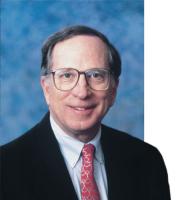
Sam Nunn, Former Senator (GA)
Nuclear Threat Initiative
Chaired by Sam Nunn... and
Ted Turner?! |
1991
Nunn-Lugar
Cooperative Defense
Initiative
|
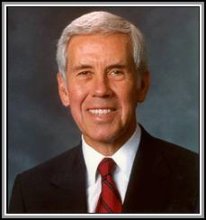
Senator Richard Lugar (MN) |
In response to the collapse of
the Soviet Union:
"Congress established the Nunn-Lugar
Cooperative Threat Reduction Program (CTR)
in 1991 so that the United States could
assist the former Soviet republics with
the safe and secure transportation,
storage, and elimination of nuclear
weapons. The CTR program seeks to reduce
the threat these weapons pose to the
United States and to reduce the
proliferation risks from nuclear weapons
and materials in the former Soviet
Union. Congress has authorized and
appropriated around $300-$400 million
each year for CTR. Most in Congress
support the core objectives of the CTR
program, but some have questioned
whether all of the proposed and ongoing
projects contribute to U.S. national
security."
CRS 97-1027F
The seeds of our destruction
were in the Nunn-Lugar Cooperative Threat Reduction (CTR)
Program. In the transport, chain of custody, and
tracking of nuclear materials - point of origin to point of
destruction - coupled with the capabilities of the Internet
for information sharing, the idea for the global supply
chain management system was born.
A brief paper on the genesis
of the CTR legislation and program was found on the Duke
University website. It's a must read for understanding of
what follows.
'Cooperative Security and the Nunn-Lugar Act' by Scott
Kohler
An good explanation of the Cooperative Threat Reduction
Program was found in a GAO report to a congressional
committee on National Security
DOD’s program to convert former Soviet Union
defense industries to commercial enterprises
is part of the Cooperative Threat Reduction
program, which DOD has supported since 1992 to
reduce the weapons of mass destruction (WMD)
threat.2 The program’s priority objectives include
helping to (1) destroy nuclear, biological, and
chemical weapons; (2) transport and store
weapons that are to be destroyed; and (3) prevent
weapon proliferation. In addition to these
objectives, the Cooperative Threat Reduction Act
of 1993
authorized DOD to establish a program to help
demilitarize former Soviet Union defense
industries and convert military technologies and
capabilities to commercial activities. The
Soviet Union had an enormous defense industrial
complex that reportedly consisted of 2,000 to
4,000 production enterprises, research and
development facilities, and research institutes
and employed between 9 million and 14 million
people.3
A
nation can survive its fools, and even the
ambitious. But it cannot survive treason from
within. An enemy at the gates is less formidable,
for he is known and carries his banner openly. But
the traitor moves amongst those within the gate
freely, his sly whispers rustling through all the
alleys, heard in the very halls of government
itself. For the traitor appears not a traitor; he
speaks in accents familiar to his victims, and he
wears their face and their arguments, he appeals
to the baseness that lies deep in the hearts of
all men. He rots the soul of a nation, he works
secretly and unknown in the night to undermine the
pillars of the city, he infects the body politic
so that it can no longer resist. A murder is less
to fear: Cicero Marcus Tullius
|
|
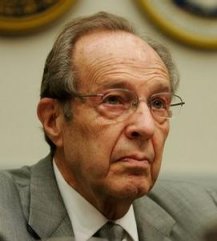
William Perry, Secretary of
Defense
Feb. 1994 - Jan. 1997
|
Mutually
Assured
Destruction
~ By Means Other Than War ~
Perry adopted "Preventative Defense" as his national
defense strategy.
"In May 1994 he and General John M. Shalikashvili,
chairman of the Joint Chiefs of Staff, announced that
Defense would go forward, as required by law, with a 1995
round of base closings. In doing so Defense would consider
the economic impact on the affected communities and the
capacity to manage the reuse of closed facilities." |
|
U.S.
Disarmament
"On September
25, 1961, John F. Kennedy gave a speech at the
United Nation calling for the complete disarmament
of the United States and Soviet Union. The next
day, September 26, 1961, Kennedy signed Public Law
87-297, "Arms Control and Disarmament Act". In
the over fifty years since, our government and
military leaders have been disarming our country -
and looting it at the same time. We were funding
a military that was being dismantled in the United
States - and building a military offshore. So it
would seem, the only real 'superpower' this
government has is the ability to create a false
reality for the masses using Mainstream Media and
American Pravda wire service as the
funnels for propaganda and social conditioning for
the demise of the nation."
Arms Control and
Disarmament Act - Public Law 87-297
Definitions:
Sec. 3. As
used in this Act--
(a) The terms "arms control" and
"disarmament" mean the identification,
verification, inspection, limitation, control,
reduction, or
elimination, of armed forces and armaments of all
kinds
under international agreement including the
necessary steps taken under such an agreement to
establish an effective system of international
control, or to create and strengthen international
organizations for the maintenance of peace.
|
In a report to Congress titled,
"Non-Technical
Constraints and Barriers to Implementation of Intelligent
Vehicle-Highway Systems", it said the following
regarding use of Defense Contractors for the IVHS industry:
It is estimated
that IVHS-related employment will rise from 21,000
in 1996 to 219,000 in 20 11. By 20 11, employment
in the IVHS sector will account for a substantial
share of the work force for certain highly skilled
occupations. There should, however, be no major
difficulty in meeting that demand.
The
Nation’s declining defense sector could be an
important source of scientific, professional, and
technical expertise for the IVHS industry.
However, IVHS products and services will be
deployed, operated, and maintained under
conditions that are quite different from
traditional defense sector practices, such as
building relatively few high-technology products
for a single client.1
1994 Congress authorized a new commission, "Commission on
Rolls and Missions of the Armed Forces". Their report,
"Directions
for Defense" was published May 24, 1995.
Recommendations:
Our recommendations emphasize the roles of the chairman
of the Joint Chiefs of Staff and the CinCs' joint
"core competency"
in preparing for and conducting unified operations.
We recommend a new,
functional unified command responsible for joint training
and integration of all forces based in the continental
United States. Under the direction of the secretary of
defense, this new command would train and provide the joint
forces required by the geographic CinCs' operational plans.
The command would work with the geographic CinCs in
developing appropriate plans and training programs for joint
and combined operations.
(Northern
Command?)
Information Warfare. We recommend a high-level
interagency effort to improve America's information warfare
capacity. DoD's capabilities for this emerging war-fighting
mission need to be improved, and U.S. civil and military
information vulnerabilities must be reduced.

Joint Vision 2010, Focused Logistics Roadmap, Shalikashvili
More than a quarter of a
million DoD employees engage in commercial-type activities
that could be performed by competitively selected private
companies. Experience suggests achievable cost reductions of
about 20 percent.
DoD should outsource
essentially all wholesale-level warehousing and
distribution, wholesale-level weapon system depot
maintenance, property control and disposal, and
incurred-cost auditing of DoD contracts. In addition, many
other commercial-type activities, including those in family
housing, base and facility maintenance, data processing and
others, could be transferred to the private sector. Finally,
DoD should rely on the private sector for all new support
activities.
We rejected a monolithic new
acquisition organization independent of the services because
it could undermine core combat capabilities. Instead, we
concentrated on improving the infrastructure that supports
buying and maintaining military equipment.
Support activities that remain
in the government should be re-engineered to improve
performance and reduce cost, and they should adopt
private-sector management tools that increase efficiency.
We recommend re-engineering
DoD's centralized contract audit and oversight functions,
including greater use of private sector audits and
electronic auditing wherever possible. Furthermore, the
Defense Contract Management Command and the Defense Contract
Audit Agency should be combined. More generally, DoD needs
relief from laws and regulations that prevent using proven
commercial business processes, such as activity-based cost
accounting and international quality assurance standards.
Many of the defense agencies
and field activities that provide the bulk of
DoD's centralized
support must become more efficient and responsive to their
customers. We recommend establishing a board of
directors for each defense agency and major field activity.
These boards
should include customer representatives and be supported by
expert consultants to promote adoption of innovative
management practices. Their purview should extend
beyond financial accounting matters to address the full
range of customer needs.
We recommend collocating the
military departments' aircraft program management offices
and consolidating common business and engineering activities
that support the program managers. Matrix support will
reduce overall personnel costs by assigning experts to
individual Service program offices only as needed. This
should also increase aviation interoperability and
commonality over time.
We recommend a
thorough restructuring of the existing DoD planning and
budgeting system. Taking its initial direction
from the QSR, the system we propose features more orderly
treatment of issues, stronger program and budget direction
by the secretary and greater stability. We also believe that
our system will provide better focus on important issues by
senior officials and require considerably less staff effort
devoted to detail.
The department's
decision-making information support framework -- the Future
Years Defense Program -- is too input oriented. We recommend
a mission/output-oriented information framework to better
enable the assessment of forces and capabilities to perform
missions derived from the National Security Strategy. The
new framework would include improved metrics for measuring
and tracking performance.
(Outputs come from inputs - so if you don't input, what are
you outputting? Data from models? Pure fiction.) |
Foreign
Access To Remote Sensing Space Capabilities
Presidential Decision
Directive - PDD-23
March 10, 1994
Background
Remote sensing from space
provides scientific, industrial, civil governmental,
military and individual users with the capacity to gather
data for a variety of useful purposes. The Us
Government operates very high resolution space- based
reconnaissance systems for intelligence and military
purposes. These systems are among the most valuable Us
national security assets because of their high quality data
collection, timeliness, and coverage and the capability they
provide to monitor events around the world on a near
real-time basis. More nations have discovered the
value of these satellites and are developing their own
indigenous capabilities, or are seeking the purchase of data
or systems.
Transfer of Advanced
Remote Sensing Capabilities
1. Advanced Remote Sensing
System Exports: The United States will consider requests
to export advanced remote sensing systems whose performance
capabilities and imagery quality characteristics are
available or are planned for availability in the world
marketplace on a case-by-case basis.
Transfer of Sensitive
Technology
The United States will
consider applications to export sensitive components,
subsystems, and information concerning remote sensing space
capabilities on a restricted basis. Sensitive technology in
this situation consists of items of technology on the Us
Munitions List necessary to develop or to support advanced
remote sensing space capabilities and which are uniquely
available in the United States. Such sensitive technology
shall be made available to foreign entities only on the
basis of a government-to-government agreement. This
agreement may be in the form of end-use and retransfer
assurances which can be tailored to ensure the protection of
Us technology.
Government-to-Government Intelligence and Defense
Partnerships
Proposals for intelligence or
defense partnerships with foreign countries regarding remote
sensing that would raise questions about Us Government
competition with the private sector or would change the Us
Government's use of funds generated pursuant to a Us-foreign
government partnership arrangement shall be submitted for
interagency review.
Landmark Directive: Commercial Remote Sensing and
National Security3
Global Positioning and Military Satellites for Commercial
Use
1996 - Presidential Decision Directive PDD/NSTC-6 -
Global Positioning System Policy, March 28, 1996
Allowing civil and commercial use of military
satellites for Global Positioning (GPS)
applications
GLOBAL POSITIONING SYSTEM POLICY
ANNOUNCED -
May 6, 1996
"Under Secretary of Defense for
Acquisition and Technology Paul G. Kaminski today
participated in a White House ceremony announcing the first
comprehensive statement of U.S. policy on the management and
use of the Global Positioning System. According to Kaminski,
this policy statement marks a milestone in the evolution of
GPS as a critical defense resource and an equally critical
economic and scientific resource that will benefit the U.S.
and the world. It represents the best of American scientific
and technical ingenuity and highlights the positive results
that can be achieved when the military and civil sectors
cooperate in creating a true dual use system.
GPS consists of a constellation of 24 satellites, a
worldwide signal monitoring and control network and a broad
family of military and civilian user equipment. As the
developer and operator of GPS, the Defense Department has
been an active proponent of its use for civilian purposes.
GPS is intended to provide a substantial military
competitive advantage for the U.S. and its allies over any
potential adversaries while at the same time serving a broad
range of civilian applications. In fact, GPS has already
proved its military effectiveness during Desert Storm and
humanitarian operations in Somalia, Haiti and Bosnia and is
now being fully integrated into virtually every facet of
U.S. military operations.
At the same time, GPS applications have grown enormously
in the civilian sector. GPS use already exists far beyond
the simple scope of navigation and positioning, as the
system has evolved into an information resource and an
integral part of the Global Information Infrastructure.
Throughout this process, DoD has worked in close partnership
with both federal and private civil organizations to bring
GPS into full operational use for civilian as well as
military benefit.
xxxxxxxxxxxxxxxxxxxxxxxxxxxxxxxxxxxxxxxxxxxxxx
|

William Cohen, Secretary of Defense
Jan. 1997 - Jan. 2001
During his years
in Congress, he found time to write or co-author
eight books: three non-fiction works, three
novels, and two books of poetry. [yeah
right]
Memory Hole - Press Conferences with Cohen
RAND Analyst Admits Defense Secretary fits profile
of domestic terrorist? |
1997 Defense Reform Initiative

I accuse this man, William Cohen, of high treason against the United
States of America for the sabotage of Defense Department
Computer Systems for the purpose of undermining U.S. defense
capability through privatization of national security and
commercialization of defense technology. This sabotage
was accomplished under the cover of the "1997 Defense Reform
Initiative: Reinvention of Government".
Following September 11, 2001,
on November 9, 2001, President George Bush signed an
agreement with India for dual-use Defense Technology
Transfer giving the excuse of terrorism for the agreement.
The initiative for this agreement was called the
Knowledge Trade
Initiative and it was the work of the Clinton
Administration.
|
|

From the About Page on the
Cohen Group website:
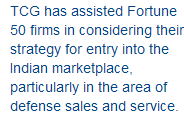  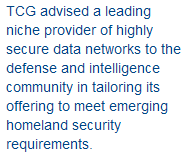
|
| |
SECRETARY COHEN ESTABLISHES TASK FORCE ON DEFENSE
REFORM - Ref No. 238-97
Reporting through Hamre, task force
members are Michael J. Bayer, a
consultant in business-government
relations who served as an official in
both the Energy and Commerce
departments; David Chu, director of
RAND's Washington office and former DoD
director of program analysis and
evaluation; Rhett Dawson, president,
Information Technology Industry Council;
James Locher, former assistant secretary
of defense for special operations and
low- intensity conflict; Arnold Punaro,
senior vice president for corporate
development at Science Applications
International Corporation and former
staff director of the Senate Armed
Services Committee; Kim Wincup, a
program director at Science Applications
International Corp. and a former
assistant secretary of the Army, and Dov
Zakheim, corporate vice president and
director, Center for Policy Planning,
System Planning Corporation and chief
executive officer, SPC International and
former deputy under secretary of defense
for planning and resources. Cohen said
that several other members may be named.
Areas
of primary focus for the task force
include: · Reform of the Office of the
Secretary of Defense (OSD). The task
force is to go beyond a mere review of
size to reexamine the appropriate role
and organization of OSD. · Review of
Defense Agencies and DoD Field
Activities. During the past ten years,
the Defense Agencies and DoD Field
Activities have grown significantly, and
the Department lacks structure to
provide adequate corporate oversight of
these agencies and activities. The task
force will go beyond the recommendations
of the QDR and develop a blueprint for
further streamlining and reform. ·
Reform of enterprise-wide business
practices. The task force will identify
additional opportunities for
enterprise-wide reform of business
practices in the areas of acquisition,
logistics, installation operations, and
property management.
“Over
the past decade, the American commercial
sector has reorganized, restructured,
and adopted revolutionary new business
and management practices in order to
assure its competitive edge in the
rapidly changing global marketplace. Now
the Department must adopt and adapt the
lessons of the private sector so our
armed forces can maintain their
competitive edge in the
rapidly changing global security market,”
said Secretary Cohen.
I accuse this man of high treason against the United
States of America for the sabotage of Defense Department
Computer Systems for the purpose of undermining U.S. defense
capability through privatization of national security and
commercialization of defense technology. This sabotage
was accomplished under the cover of the "1997 Defense Reform
Initiative: Reinvention of Government".
|
|
War By Other Means
Communism is a Comfidence
Game - deception, corruption, theft, trickery and
tyranny |
|
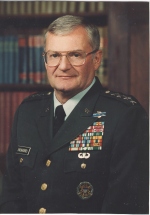
Gen. John M. Shalikashvili,
Chairman of Joint Chiefs of Staff 1993-1997
Initiative for Global Development
"He also serves on the board
of directors of The Boeing Company, United Defense, L-3
Communications Corporation, the Frank Russell Trust Company,
United, Inc., as well as the Atlantic Council and various
military organizations."
NBR |

Shalikashvili's Program - Click
the image for the details |
|
Military
Supply Chain (Logistics) Management
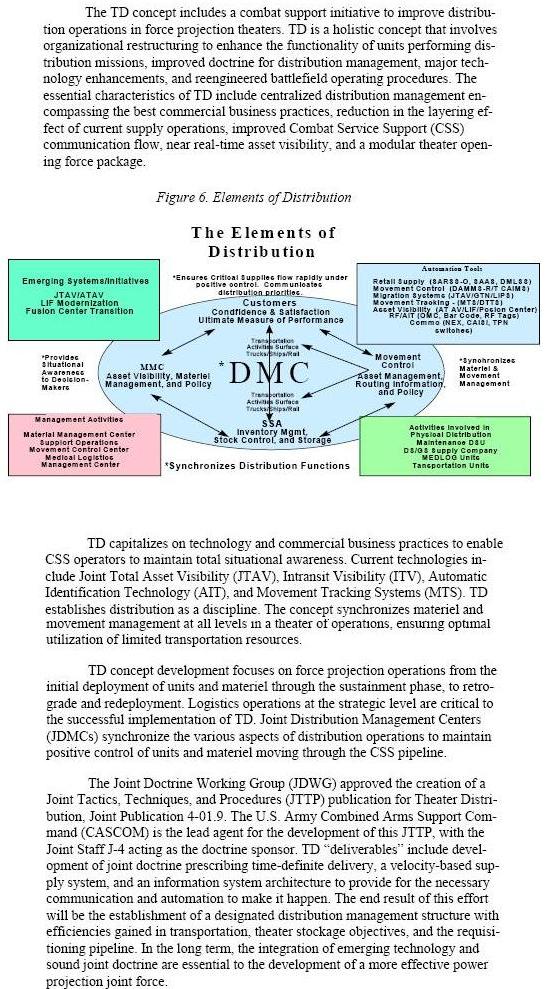 |
|
The military
logistics system described above for surveillance and
control of the "battlespace" and supply distribution to the
"warriors" is
THE SAME SYSTEM.... repeat
THE SAME SYSTEM
as is being installed under the facade of a commercial
venture called (NASCO) NAFTRACS - freight tracking, traffic
management systems, emergency command and control.
THE SAME SYSTEM
North
American Supercorridor Coalition (NASCO)
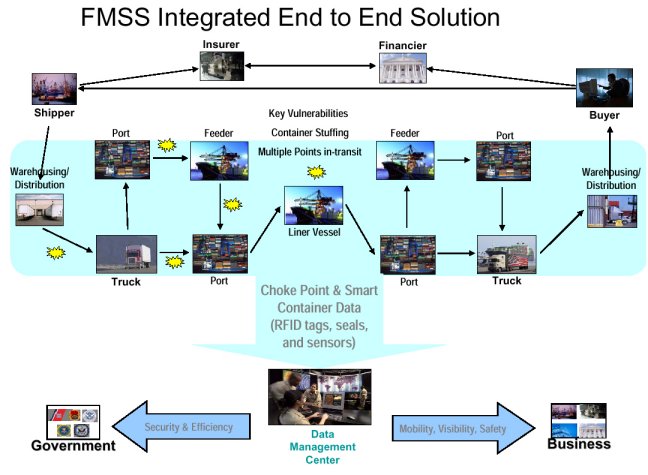 |
|
Minnesota Department of Transportation
Corridors of the Future
U.S. Transportation
System
SAME TECHNOLOGY - SAME SYSTEM as Battlespace America
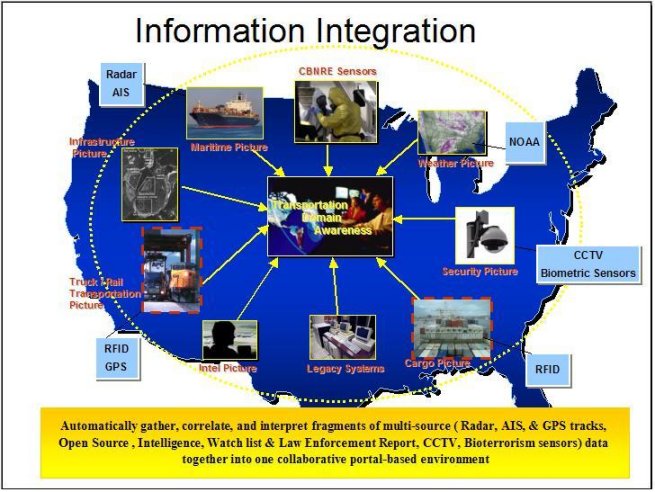
Notice IRRIS on this NASCO
Slide

NASCO
Slide Presentation on NAFTRACS by Frank Conde (Slide 11)
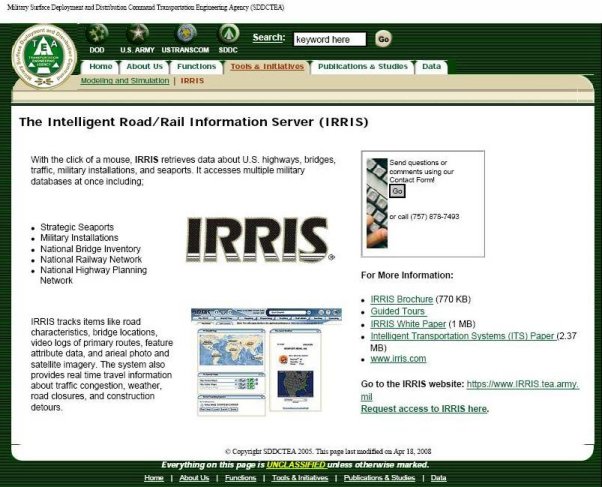
http://www.tea.army.mil/tools/irris.htm
|
|
|
|
|
Throughout
The 1990's
Y2K TERROR
TERROR TERROR Y2K TERROR TERROR
TERROR Y2K TERROR TERROR TERROR
Hyperbole is a marketing
tool for selling computer systems. "If we don't do
this system RIGHT NOW planes will crash, ships will sink,
trains will derail, buildings will fall down....
"Gold Fever + Y2K
Marketing Opportunity + Blue Sky Reinvention (Redesign) of
Government = BILLIONS AND BILLIONS AND BILLIONS of stars..
no, wait I was channeling Carl Sagan... BILLIONS
AND BILLIONS AND BILLIONS OF DOLLARS for new technology and
redesign government systems... Powerful
incentives for a little bit of covert demolition.
Terrorism for "fun (transformation to a totalitarian state)
and profit (government technology contracts &
public-private partnerships as payoffs to public officials
to maintain a blind eye and invincible ignorance).
The following report was a
product of the 'Preventative Defense' project initiated by
Secretary of Defense William Perry. Perry and Ashton
Carter are Co-Directors.
Catastrophic Terrorism: Elements of a National Policy
~ 1998
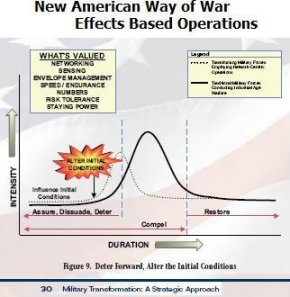
|
|
Infinite and Highly Profitable Loop
Fear • Money • More Fear • More Money
• More Fear • More Money
• More Fear
Technology
for Terrorism - Terrorism for Technology
1993 - World Trade Center Truck Bomb
CBS News Footage (YouTube) on FBI involvement
Who Bombed the World Trade Center? - 1993
By Ralph Growing Evidence of FBI Involvement
1993 - Waco - Branch Davidians , Joint Military -
Domestic Law Enforcement Demonstration Project
Report to the Deputy
Attorney General on the Events at Waco, Texas
February 28 to April 19, 1993
Clark tanks used in Waco siege
World Net Daily
Between August 1992
and April 1994, [Wesley]
Clark was commander of the 1st Cavalry Division of
the Army's III Corps at Fort Hood, Texas.
According to a report by the U.S. Department of
the Treasury, the list of military personnel and
equipment used at Waco included: 15
active-duty
military personnel, 13 Texas National Guard
personnel, nine Bradley fighting vehicles, five
combat-engineer vehicles, one tank-retrieval
vehicle and two M1A1 Abrams tanks. Additionally,
Fort Hood reportedly was used for much of the
training for the bloody attack on the Davidians
and their children.
Based on the fact
that military equipment from Fort Hood was used in
the siege and that training was provided there,
say critics, it is clear the commanding officer of
the 1st Cavalry had direct knowledge of the attack
and, more likely than not, was involved in the
tactical planning.
West Point graduate
Joseph Mehrten Jr. tells Insight, "Clark had to
have knowledge about the plan because there is no
way anyone could have gotten combat vehicles off
that base without his OK. The M1A1 Abrams armor is
classified 'Secret,' and maybe even 'Top Secret,'
and if it was deployed as muscle for something
like Waco there would have been National Firearms
Act weapons issues. Each of these M1A1 Abrams
vehicles is armed with a 125-millimeter cannon, a
50-caliber machine gun and two 30-caliber machine
guns, which are all very heavily controlled items,
requiring controls much like a chain of legal
custody. It is of critical importance that such
vehicles could not have been moved for use at Waco
without Clark's knowledge."
Was Clark at Waco? CounterPunch
Wesley Clark - connection to Ambassador Richard
Holbrooke
Wesley Clark: The Truth Behind Kosovo - KLA
Terrorists
Richard Holbrooke - 9/11 Creating The Myth
1995 - Oklahoma City
Proof of additional explosives
Oklahoma City News Reports - secondary devices
The OKC-9/11 connection, again
1996 - TWA Flight 800
explodes midair shortly after takeoff
Was TWA 800 Shot Down By a Military Missile?
Cooperative Engagement Capability
May 11, 1996 - Valujet Crashes in Everglades
Holiday Park
On
a muggy May afternoon in 1996 an
emergency dispatcher in southern Florida
got a call from a man on a cellular
phone. The caller said, "Yes. I am
fishing at Everglades Holiday Park, and
a large jet aircraft has just crashed
out here. Large. Like airliner-size."
The dispatcher said, "Wait a minute.
Everglades Park?"
"Everglades Holiday Park, along canal
L-sixty-seven. You need to get your
choppers in the air. I'm a pilot. I have
a GPS. I'll give you coordinates."
[What are the
odds? The policy for civilian use
was announced on May 6, 1996]
September 11, 2001 - 3
Buildings Demolished,
September 18, 2001 -
Anthrax
|
|
Future
Combat Systems - Boyz and Their Toyz
|
| |
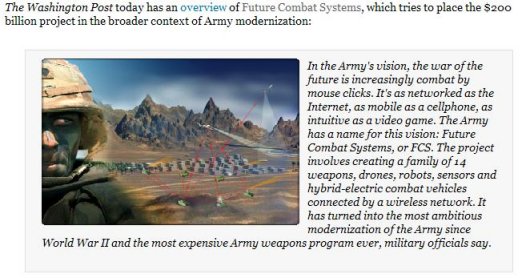 |
|
|
|
|
Military Data Fusion
Center
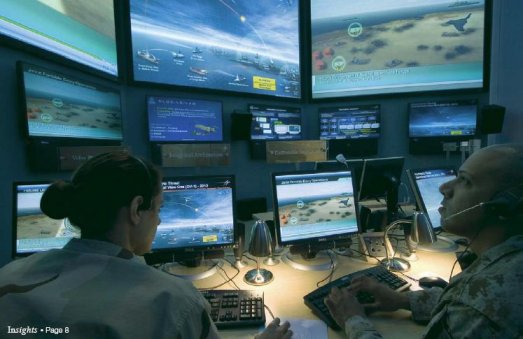
Lockheed - Insights Volume 3,
Number 2, 2006, Page 8
Civilian Data Fusion Center
Point, Click and Disable Your
Breaks
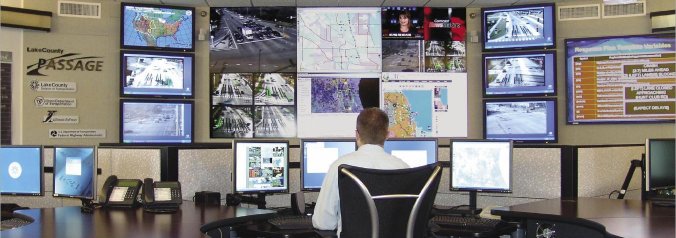 |
|
|
|
Human ID at a
Distance |
|
Real ID -
Chipped for GPS Tracking
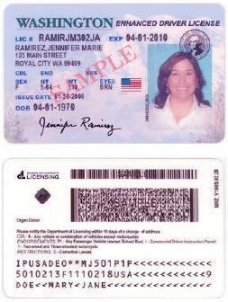
Real ID - "A
Global Security Envelope"
Real ID -
Fusion Center |
Human
Asset, Fusion Center Information Screen
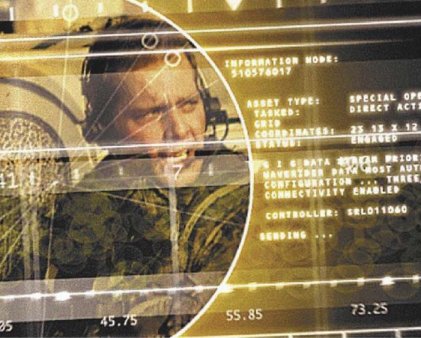 |
|
Real ID for
Children

|
|
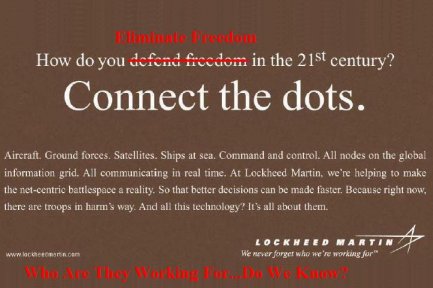 |
|
http://www.presidioincorporated.com/
http://findarticles.com/p/articles/mi_m0EIN/is_2001_Jan_31/ai_69752197
http://epic.org/privacy/budget/fy2006/
http://www.ntia.doc.gov/reports/giiagend.html
http://www.brasschecktv.com/page/368.html
http://www.spectra-research.com/sppdf/RFtag_flyer.pdf
http://www.co.lake.il.us/elibrary/publications/dot/passage%20brochure_web.pdf
http://www.lockheedmartin.com/data/assets/innovation/documents/Insights2Q2006.pdf
|
|
|
|
|
|
|
|
|
|
|
|
|
|




































